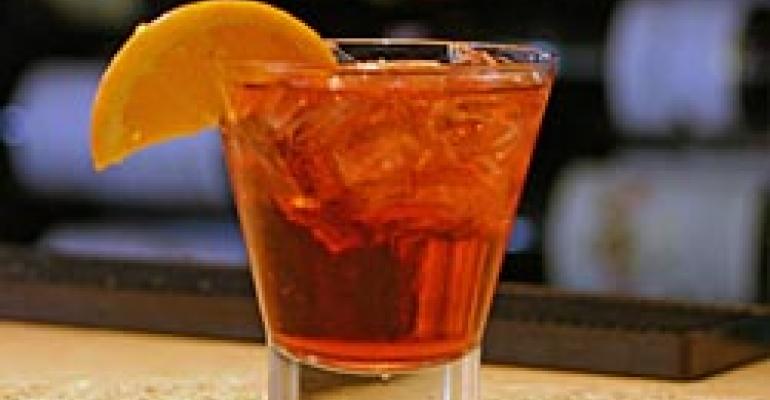Maybe it's due to the exotic botanicals on the nose or the whiff of Jazz Age glamour. Or the way it makes a cocktail taste like more than the sum of its parts. For those reasons and more, gin stands taller at the bar today than it has in years. Creative barkeeps are having a field day mixing it with Campari and sweet vermouth in the retro-revival Negroni cocktail, not to mention inventing newfangled libations. Examples of the latter include signature drinks made with gin and muddled seasonal blueberries and peaches and a novel tipple made from sugar snap peas soaked in gin.
The smooth, dry spirit, now available from a growing number of high-quality boutique producers, is catching on with young adults. "It used to be a 'man's man' kind of drink, but I see more ladies and people in their mid-20s drinking it now," said Joseph Boroski, head mixologist at Monkey Bar in New York City. He likes to match gin with simple muddled fresh fruit in a tall, iced Peach Collins.
"There was a time when you never asked whether a customer wanted vodka or gin in a martini," said Gary Sullivan, co-owner of Rocca Kitchen & Bar in Boston. "You assumed it was vodka." Today, he reports increasing calls for gin not only in martinis but in Negronis. He deviates from the Italian-inspired classic cocktail's usual recipe by infusing Hendrick's Gin with rosemary sprigs and combining it with Campari and Punt e Mes, an Italian vermouth with a bitter nuance.
Gin fans say it's the botanicals — the mix of herbs, berries, seeds and spices distilled with the spirit for flavor and aroma — that makes gin shine in a cocktail. Juniper berries may be the most familiar, but distillers also use things like citrus peel, cinnamon, cardamom, caraway, anise and lavender. There are literally hundreds of choices. "When you have all those botanicals densely tied together and mixed into a complex cocktail, it becomes something entirely new," said mixologist Ryan Magarian, president of Liquid Relations, a cocktail consulting firm based in Portland, Ore.
Even so, gin's rebound has been a long time coming, and it's still a work in progress. But back in the Jazz Age of the 1920s, it was the toast of the cocktail set. However, by the turn of the century, vodka had swamped gin like a tidal wave, propelled by its neutral, mixable nature. Today, thanks largely to the craft movement in bartending, spirits like gin that have greater character are getting a new look. "To me, vodka will always be around, like chicken dishes on menus," said Magarian. "But mixologists who are really into the craft are kind of going away from it. You don't see [celebrity chef] Thomas Keller making chicken dish after chicken dish."
To attract converts to gin, Magarian dangles the Honey Basil Sling. Created for Katsuya restaurant in Los Angeles, it features muddled fresh basil, house-made honey syrup and freshly squeezed lemon juice laced with Plymouth Gin, shaken and strained over ice and topped with soda. It harkens back to the slings of the 17th century, tall drinks originally made with spirits, sugar and water.
"To me, gin is a far more interesting ingredient," said Tim Lacey, bar manager and beverage director of the Spring Restaurant Group in Chicago, which operates the dining spots Spring, Green Zebra and Custom House. His favorite summer drink at Custom House is Blue Ruin, a muddle of fresh Michigan blueberries and Martin Miller's Gin, served on the rocks with a splash of soda. His most daringly different creation is Miss Angela, a drink named after the copper still used to make Martin Miller's in England. It's simply an infusion of fresh sugar snap peas borrowed from the kitchen. The sugar snaps soak in gin for a few days and then are strained out. The infusion is chilled, finished with a pinch of salt and citric acid and served straight up. "It works nicely," said Lacey. "It's a little difficult getting it in front of people. But I haven't had any sent back."
At Sona, a modern French restaurant in West Hollywood, Calif., chef-owner David Myers causes a stir with the Cucumber Cocktail, a drink he describes as "a cucumber mojito made with gin." He muddles three slices of fresh cucumber with a handful of fresh mint and a sugar cube and tosses that into a shaker with ice, Plymouth Gin and fresh lime juice. After a few shakes, he adds some egg white and resumes shaking. The tangy, frothy elixir is a big hit at Sona. "People are just nuts about it," said Myers.




